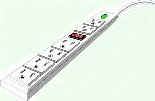Lesson #3: How to turn your computer on and off
Since you are reading this, one could assume that you know how to turn your computer on. But, believe it or not, there is a right way and a wrong way. A computer is electronic and is sensitive to the flow of electricity.

You don't want power surges. (If you don't have a surge protector between your computer and the wall outlet that it is plugged into, get one NOW. You've paid good money for your computer.....protect it and all your programs.)
Turn on any appliances connected to your computer first....your monitor, your printer, etc. Then turn on your computer.
To shut your computer off, use the "Shut Down" option on your Start Menu so that the inner workings of your computer will be shut down properly. That is, go to the Start Button on the lower left of your screen. Click once on the Start Button. Then click once on the "Shut Down" selection. Your computer will churn and belch and eventually tell you that "It is now safe to turn off your computer". Turn off your main computer switch and then turn off any attached appliances.
When you turn your computer off, wait at least 10-15 seconds before you turn it back on. Let all those electrons go wherever electrons go when you shut down your computer, let the energy dissipate, then start over again.
Your computer is sensitive to static electricity as well. If you experience "shocks" when you walk across your carpet and flip the light switch or touch metal, you can "shock" your computer! Be sure to discharge the static electricity before you go near your computer.
Just remember that your computer should be
"Last on and First off".
If you do have a surge protector, you can plug your computer, your monitor, your printer, etc. into it and turn everything on and off with one switch. That is safe to do.
You should also consider getting a UPS (Uninterruptable Power Supply). If there is a power failure (during a storm or whatever), a UPS will provide battery power to your computer long enough for you to turn everything off in an orderly manner so that you don't lose your data. More about UPS when we get to computer maintenance.
It's not supposed to happen, but every so often your computer will get "hung up". That is, it will stop responding to you no matter what you do. You can't type; your mouse doesn't do anything, etc. When that happens, (notice I didn't say 'If') press the ALT + CTRL + DELETE keys all at the same time. You will get a Close Program dialog box which will list all the programs you currently have open. Click on the name of the program which is not responding and click on "End Task". Or you can click "Shut Down" to turn your computer off. (You will lose any information you have not yet saved....which is why it is a good idea to "Save as you go". You will learn how to save your work in the practice session of Lesson #4)
Windows* doesn't like it when you shut your computer off without going through the shut down sequence. Windows* checks to see if you have changed any settings and if you have anything stored in memory that should be saved to a file before it shuts down your computer, so if you do not go through the sequence, if you simply flip the switch or pull the plug, when you restart your computer Windows* will do a ScanDisk to check the files and folders on your hard disk for data errors. We'll discuss ScanDisk more when we talk about computer maintenance.
There's no practice session for this lesson. You get lots of practice turning your computer on and off, I'll bet!
Next we'll look at mouse use.
End of Lesson3.
Click here to return to table of contents.
*Windows* refers to Microsoft Windows 95® or Microsoft Windows 98®.
